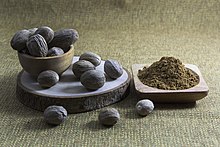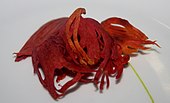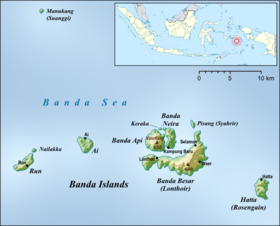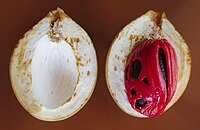Nutmeg
 | |
| Type | Seed and ground spice |
|---|---|
Nutmegis theseed,or the groundspicederived from that seed, of several tree species of the genusMyristica;[1]fragrant nutmegortrue nutmeg(M. fragrans) is a dark-leavedevergreentree cultivated for twospicesderived from itsfruit:nutmeg, from its seed, andmace,from the seed covering. It is also a commercial source of nutmegessential oiland nutmeg butter.Indonesiais the main producer of nutmeg and mace, and the true nutmeg tree is native to its islands.
If consumed in amounts exceeding its typical use as a spice, nutmeg powder may produceallergic reactions,causecontact dermatitis,or havepsychoactiveeffects.[2]Although used intraditional medicinefor treating various disorders, nutmeg has no scientifically confirmedmedicinal value.[2]
Conifersof the genusTorreya,commonly known as the nutmeg yews, have edible seeds of similar appearance, but are not closely related toM. fragrans,and are not used as a spice.
Common nutmeg[edit]
Nutmeg is the spice made by grinding the seed of the fragrant nutmeg tree (Myristica fragrans) into powder. The spice has a distinctive pungent fragrance and a warm, slightly sweet taste; it is used to flavor many kinds of baked goods, confections,puddings,potatoes, meats, sausages, sauces, vegetables, and such beverages aseggnog.[3]
The seeds are dried gradually in the sun over a period of 15 to 30 weeks. During this time, the nutmeg shrinks away from its hard seed coat until the kernels rattle in their shells when shaken. The shell is then broken with a wooden club and the nutmegs are picked out. Dried nutmegs are greenish brown ovoids with furrowed surfaces.[3]The nutmegs are roughly egg-shaped, about 20.5–30 mm (0.81–1.18 in) long and 15–18 mm (0.59–0.71 in) wide, weighing 5–10 g (0.18–0.35 oz) dried.
Two other species of genusMyristicawith different flavors,M. malabaricaandM. argentea,are sometimes used to adulterate nutmeg as a spice.[4]
Mace[edit]

Mace is the spice made from the reddish seed covering (aril) of the nutmeg seed. Its flavour is similar to that of nutmeg but more delicate; it is used to flavour baked goods, meat, fish, and vegetables, and in preserving and pickling.[5]
In the processing of mace, the crimson-colored aril is removed from the nutmeg seed that it envelops and is flattened out and dried for 10 to 14 days. Its color changes to pale yellow, orange, or tan. Whole dry mace consists of flat pieces—smooth, horn-like, and brittle—about40 mm (1+1⁄2in) long.[6]
Botany and cultivation[edit]

The most important commercial species is the common, true or fragrant nutmeg,M. fragrans(Myristicaceae), native to theMoluccas(or Spice Islands) of Indonesia.[7][8]It is also cultivated onPenangIsland in Malaysia, in theCaribbean,especially inGrenada,and inKerala,a state formerly known as Malabar in ancient writings as the hub of spice trading, in southern India. In the 17th-century workHortus Botanicus Malabaricus,Hendrik van Rheederecords thatIndianslearned the usage of nutmeg from the Indonesians through ancient trade routes.
Nutmeg trees aredioecious plants(individual plants are either male or female), which are propagated sexually fromseedsand asexually fromcuttingsorgrafting.Sexual propagation yields 50% male seedlings, which are unproductive. Because no reliable method has been found for determining plant sex before flowering in the sixth to eighth year, and sexual reproduction bears inconsistent yields, grafting is the preferred method of propagation. Epicotyl grafting (a variation ofcleft graftingusing seedlings),approach grafting,andpatch buddinghave proved successful, with epicotyl grafting being the most widely adopted standard.Air layeringis an alternative though not preferred method because of its low (35–40%) success rate.
The first harvest of nutmeg trees takes place 7–9 years after planting, and the trees reach full production after 20 years.
-
Nutmeg fruit
-
Redariland seed within fruit
-
Aril surrounding nutmeg seed
Culinary uses[edit]

Spice[edit]
Nutmeg and mace have similar sensory qualities, with nutmeg having a slightly sweeter and mace a more delicate flavour. Mace is often preferred in light dishes for the bright orange,saffron-like hue it imparts. Nutmeg is used for flavouring many dishes. Whole nutmeg can also be ground at home usinga grater specifically designed for nutmeg[9]or amulti-purpose grating tool.[10]
InIndonesian cuisine,nutmeg is used in dishes,[11]such as spicy soups including variants ofsoto,konro,oxtail soup,sup iga(ribs soup),bakso,andsup kambing.It is also used in gravy for meat dishes, such assemur,beef stew, ribs with tomato, and European derived dishes such asbistik(beef steak),rolade(minced meat roll), andbistik lidah(beef tongue steak).
InIndian cuisine,nutmeg is used in many sweet, as well as savoury, dishes. In KeralaMalabar region,grated nutmeg is used in meat preparations and also sparingly added to desserts for the flavour. It may also be used in small quantities ingaram masala.[12]
In traditionalEuropean cuisine,nutmeg and mace are used especially inpotatoand spinach dishes and in processed meat products; they are also used in soups, sauces, and baked goods. It is also commonly used inrice pudding.InDutch cuisine,nutmeg is added to vegetables such as Brussels sprouts, cauliflower, and string beans. Nutmeg is a traditional ingredient inmulled cider,mulled wine,junketandeggnog.In Scotland, mace and nutmeg are usually both ingredients inhaggis.InItalian cuisine,nutmeg is used as part of the stuffing for many regional meat-filled dumplings liketortellini,as well as for the traditionalmeatloaf. Nutmeg is a common spice forpumpkin pieand in recipes for otherwinter squashes,such as bakedacorn squash.In the Caribbean, nutmeg is often used in drinks, such as theBushwacker,Painkiller,and Barbadosrumpunch. Typically, it is a sprinkle on top of the drink.
Fruit[edit]

Thepericarp(fruit covering) is used to make jam, or is finely sliced, cooked with sugar, and crystallised to make a fragrant candy. Sliced nutmeg fruit flesh is made asmanisan(sweets), either wet, which is seasoned in sugary syrup liquid, or dry coated with sugar, a dessert calledmanisan palain Indonesia. InPenang cuisine,dried, shredded nutmeg rind with sugar coating is used as toppings on the uniquely Penangais kacang.The flesh of the nutmeg fruit is also blended, in the fresh state, into a type ofsmoothie(white in colour and having a fresh, ‘green’, tangy taste); or boiled, resulting in a brown liquid, much sweeter in taste, which is used in the preparation of iced drinks. In KeralaMalabar regionof India, it is used for juice, pickles and chutney.[12]
Essential oil[edit]
The essential oil obtained bysteam distillationof ground nutmeg[13]is used in theperfumeryandpharmaceuticalindustries. Thevolatilefraction contains dozens ofterpenesandphenylpropanoids,includingD-pinene,limonene,D-borneol,L-terpineol,geraniol,safrol,andmyristicin.[13][14][15]In its pure form, myristicin is atoxin,and consumption of excessive amounts of nutmeg can result in myristicin poisoning.[16]
The oil is colorless or light yellow, and smells and tastes of nutmeg. It is used as a natural food flavoring inbaked goods,syrups, beverages, and sweets. It is used to replace ground nutmeg, as it leaves no particles in the food. The essential oil is also used in the manufacturing oftoothpasteandcough syrups.[17]
Nutmeg butter[edit]
Nutmeg butter is obtained from the nut byexpression.It is semisolid, reddish-brown in colour, and has the taste and smell of nutmeg itself.[13]About 75% (by weight) of nutmeg butter istrimyristin,which can be turned intomyristic acid,a 14-carbonfatty acid,which can be used as a replacement forcocoa butter,can be mixed with other fats likecottonseed oilorpalm oil,and has applications as an industriallubricant.
History[edit]

The earliest evidence of use of nutmeg comes in the form of 3,500-year-oldpotsherdresidues from the island of Pulau Ai, one of theBanda Islandsin eastern Indonesia.[18]The Banda Islands consist of eleven small volcanic islands, and are part of the largerMaluku Islandsgroup. These islands were the only source of nutmeg and mace production until the mid-19th century.[19]It was one of the spices traded over theAustronesian maritimespice tradenetwork since at least 1500 BCE.[20]
In the sixth century AD, nutmeg use spread to India, then further west toConstantinople.[21]By the 13th century, Arab traders had pinpointed the origin of nutmeg to the Banda Islands, but kept this location a secret from European traders.[21]
Colonial era[edit]
The Banda Islands became the scene of the earliest European ventures in Asia, to get a grip on the spice trade. In August 1511,Afonso de AlbuquerqueconqueredMalacca,which at the time was the hub of Asian trade, on behalf of the king ofPortugal.In November of the same year, after having secured Malacca and learning of Banda's location, Albuquerque sent an expedition of three ships led by his friendAntónio de Abreuto find it. Malay pilots guided them viaJava,theLesser Sundas,andAmbonto the Banda Islands, arriving in early 1512. The first Europeans to reach the Banda Islands, the expedition remained for about a month, buying and filling their ships with Banda's nutmeg and mace, and withclovesin which Banda had a thrivingentrepôttrade.An early account of Banda is inSuma Oriental,a book written by the Portuguese apothecaryTomé Pires,based in Malacca from 1512 to 1515. Full control of this trade by the Portuguese was not possible, and they remained participants without a foothold in the islands.
In order to obtain amonopolyon the production and trade of nutmeg, theDutch East India Company(VOC) waged a bloody battle with the Bandanese in 1621. HistorianWillard Hannaestimated that before this struggle the islands were populated by approximately 15,000 people, and only 1,000 were left (the Bandanese were killed, starved while fleeing, exiled, or sold as slaves).[22]The Company constructed a comprehensive nutmeg plantation system on the islands during the 17th century.
As a result of the Dutchinterregnumduring theNapoleonic Wars,the Britishinvaded and temporarily took control of the Banda Islandsfrom the Dutch and transplanted nutmeg trees, complete with soil, toSri Lanka,Penang,Bencoolen,andSingapore.[23]From these locations they were transplanted to their other colonial holdings elsewhere, notablyZanzibarand Grenada. The nationalflag of Grenada,adopted in 1974, shows a stylised split-open nutmeg fruit. The Dutch retained control of the Spice Islands untilWorld War II.
Connecticutmay have received its nickname ( "the Nutmeg State", "Nutmegger") from the claim that some unscrupulous Connecticut traders would whittle" nutmeg "out of wood, creating a" wooden nutmeg ", a term which later came to mean any type of fraud.[24][25]This narrative may have to do with the issue that one has tograteto obtain the spice powder, not crack a nutmeg, and this may not have been widely known by some purchasers of the product.[24]
Production[edit]
In 2019, global production of nutmeg was 142,000 tonnes, led byIndonesia,Guatemala,andIndia,having 38,000 to 43,000 tonnes each and a combined 85% of the world total.[26]
Psychoactivity and toxicity[edit]
Although used as afolk treatmentfor some ailments, nutmeg has no proven medicinal value.[2]
Effects[edit]
Ingested in small amounts as a spice, nutmeg produces no noticeable physiological or neurological response, but in large doses, both raw nutmeg freshly ground from kernels andnutmeg oilhavepsychoactiveeffects.[2][27][16]Such effects appear to derive fromanticholinergic-likehallucinogenicmechanisms attributed tomyristicinandelemicin.[16][28]Myristicin—amonoamine oxidase inhibitorand psychoactive substance[2][16]—can causeconvulsions,palpitations,nausea,eventualdehydration,and generalized body pain when consumed in large amounts.[2][27]Nutmeg may interact withanxiolyticdrugs, produceallergic reactions,causecontact dermatitis,and evoke acute episodes ofpsychosis.[2]
Varying considerably from person to person, nutmegintoxicationmay occur withside effects,such asdelirium,anxiety, confusion, headaches, nausea, dizziness, dry mouth, eye irritation, andamnesia.[2][16]Intoxication takes several hours to reach maximum effect,[2]and may last for several days.[16][27]Incidents of fatal poisoning from nutmeg and myristicin individually are uncommon.[2]
Nutmeg poisonings occur by accidental consumption in children and by intentional recreational use.[16]It is used recreationally with the intention of achieving a low-cost high resembling psychedelics, particularly by adolescents, drug users, college students, and prisoners.[29]Relatively large doses of nutmeg are required to produce effects; a majority of reported nutmeg intoxication cases appear to result from recreational use.[30]
Toxicity during pregnancy[edit]
Nutmeg was once considered anabortifacient,but may be safe duringpregnancyif used only in flavoring amounts.[2]If consumed in large amounts, nutmeg could cause premature labor and miscarriage. Nutmeg may also interact with pain relievers such aspethidine,so avoiding it during pregnancy is recommended.[31]
Toxicity to pets[edit]
The scent of nutmeg may attract pets, but it can bepoisonousif consumed in excess.[32]
See also[edit]
References[edit]
- ^"Nutmeg and derivatives (Review)".Food and Agriculture Organization (FAO) of the United Nations. September 1994. Archived fromthe originalon 30 October 2018.Retrieved29 October2018.
- ^abcdefghijk"Nutmeg".Drugs.com. 2009.Archivedfrom the original on 2020-12-16.Retrieved2017-05-04.
- ^ab"Nutmeg spice".Encyclopædia Britannica Online.
- ^"Nutmeg".www.clovegarden.com.Archivedfrom the original on 2017-02-18.Retrieved2017-07-22.
- ^Small, Ernest (2011).Top 100 Exotic Food Plants.CRC Press. p. 420.ISBN978-1439856864.Archivedfrom the original on 2023-06-30.Retrieved2019-08-27.
- ^"Mace spice".Encyclopædia Britannica Online.
- ^Amitav Ghosh(December 30, 2016)."What Nutmeg Can Tell Us About Nafta".New York Times.Archivedfrom the original on September 11, 2019.RetrievedApril 13,2017.
- ^Dotschkal, Janna (2015-06-22)."The Spice Trade's Forgotten Island".National Geographic.Archived fromthe originalon 2016-12-13.Retrieved2017-04-13.
- ^Oulton, Randal (18 February 2007)."Nutmeg Graters".CooksInfo.com.Archivedfrom the original on 10 January 2018.Retrieved8 April2018.
- ^Barber, Casey (18 February 2007)."Do you really need a Microplane for your kitchen? Yes, and here's why".today.com.Archivedfrom the original on 8 November 2019.Retrieved8 November2019.
- ^Arthur L. Meyer; Jon M. Vann (2008).The Appetizer Atlas: A World of Small Bites.Houghton Mifflin Harcourt. p. 196.ISBN978-0-544-17738-3.
- ^abPat Chapman (2007).India Food and Cooking: The Ultimate Book on Indian Cuisine.New Holland Publishers. p. 16.ISBN978-1-84537-619-2.
- ^abc"Description of components of nutmeg".Food and Agriculture Organization of the United Nations. September 1994. Archived fromthe originalon 2017-05-29.Retrieved2017-04-13.
- ^Abourashed, E. A.; El-Alfy, A. T. (2016)."Chemical diversity and pharmacological significance of the secondary metabolites of nutmeg (Myristica fragransHoutt.) ".Phytochemistry Reviews.15(6): 1035–1056.Bibcode:2016PChRv..15.1035A.doi:10.1007/s11101-016-9469-x.PMC5222521.PMID28082856.
- ^Piras, A.; Rosa, A.; Marongiu, B.; Atzeri, A.; Dessì, M. A.; Falconieri, D.; Porcedda, S. (2012). "Extraction and separation of volatile and fixed oils from seeds ofMyristica fragransby supercritical CO2:Chemical composition and cytotoxic activity on Caco-2 cancer cells ".Journal of Food Science.77(4): C448–53.doi:10.1111/j.1750-3841.2012.02618.x.PMID22429024.
- ^abcdefgEhrenpreis, J. E.; Deslauriers, C; Lank, P; Armstrong, P. K.; Leikin, J. B. (2014)."Nutmeg Poisonings: A Retrospective Review of 10 Years Experience from the Illinois Poison Center, 2001–2011".Journal of Medical Toxicology.10(2): 148–151.doi:10.1007/s13181-013-0379-7.PMC4057546.PMID24452991.
- ^Crask, Paul (2017-11-05).Grenada: Carriacou and Petite Martinique.Bradt Travel Guides.ISBN9781784770624.Archivedfrom the original on 2023-06-30.Retrieved2020-10-06.
- ^Peter Lape; Emily Peterson; Daud Tanudirjo; Chung-Ching Shiung; Gyoung-Ah Lee; Judith Field; Adelle Coster (2018). "New Data from an Open Neolithic Site in Eastern Indonesia".Asian Perspectives.57(2): 222–243.doi:10.1353/asi.2018.0015.hdl:10125/72091.S2CID165484454.
- ^"Mryristicin - - Molecule of the Month - August 2014 (HTML version)".www.chm.bris.ac.uk.Archivedfrom the original on 2022-10-06.Retrieved2022-04-28.
- ^Zumbroich, Thomas J. (2007–2008)."The origin and diffusion of betel chewing: a synthesis of evidence from South Asia, Southeast Asia and beyond".eJournal of Indian Medicine.1:87–140.
- ^abPickersgill, Barbara(2005). Prance, Ghillean; Nesbitt, Mark (eds.).The Cultural History of Plants.Routledge. p. 166.ISBN0415927463.
- ^Hanna, Willard (1991).Indonesian Banda: Colonialism and Its Aftermath in the Nutmeg Islands.Moluccas, East Indonesia: Yayasan Warisan dan Budaya Banda Neira.
- ^Giles Milton,Nathaniel's Nutmeg,1999, London: Hodder and Stoughton;ISBN0-340-69675-3
- ^abRebecca Furer (12 August 2011)."What is a Nutmegger?".Connecticut Public Radio.Archivedfrom the original on 29 October 2018.Retrieved29 October2018.
- ^"Nicknames for Connecticut".Connecticut State Library. 2018.Archivedfrom the original on 1 September 2015.Retrieved29 October2018.
- ^"World production of nutmeg, mace and cardamoms in 2019; Crops/Regions/World/Production Quantity from pick lists".Food and Agriculture Organization of the United Nations, Statistics Division (FAOSTAT). 2019.Archivedfrom the original on 12 November 2016.Retrieved12 February2021.
- ^abc Demetriades, A. K.; Wallman, P. D.; McGuiness, A.; Gavalas, M. C. (2005)."Low Cost, High Risk: Accidental Nutmeg Intoxication".Emergency Medicine Journal.22(3): 223–225.doi:10.1136/emj.2002.004168.PMC1726685.PMID15735280.
- ^McKenna, A.; Nordt, S. P.; Ryan, J. (2004). "Acute Nutmeg Poisoning".European Journal of Emergency Medicine.11(4): 240–241.doi:10.1097/01.mej.0000127649.69328.a5.PMID15249817.S2CID21133983.
- ^Rahman NA, Fazilah A, Effarizah ME (2015)."Toxicity of Nutmeg (Myristicin): A Review".International Journal on Advanced Science, Engineering and Information Technology.5(3): 212.doi:10.18517/ijaseit.5.3.518.
- ^Forrester MB (November 2005). "Nutmeg intoxication in Texas, 1998–2004".Human & Experimental Toxicology.24(11): 563–6.Bibcode:2005HETox..24..563F.doi:10.1191/0960327105ht567oa.PMID16323572.S2CID6839715.
- ^"Herb and drug safety chart".BabyCentre UK. 2018.Archivedfrom the original on 15 October 2012.Retrieved29 October2018.
- ^Charlotte Flint (2018)."Nutmeg Toxicity".Pet Poison Helpline.Archivedfrom the original on 30 October 2018.Retrieved29 October2018.
External links[edit]
 Media related toNutmegsat Wikimedia Commons
Media related toNutmegsat Wikimedia Commons Data related toMyristica fragransat Wikispecies
Data related toMyristica fragransat Wikispecies



